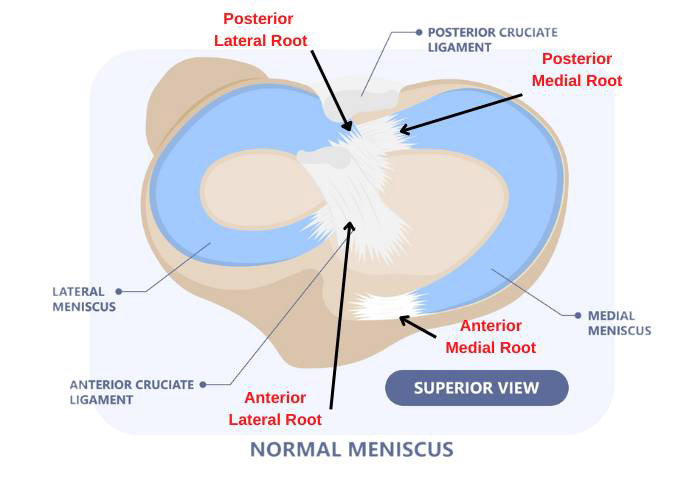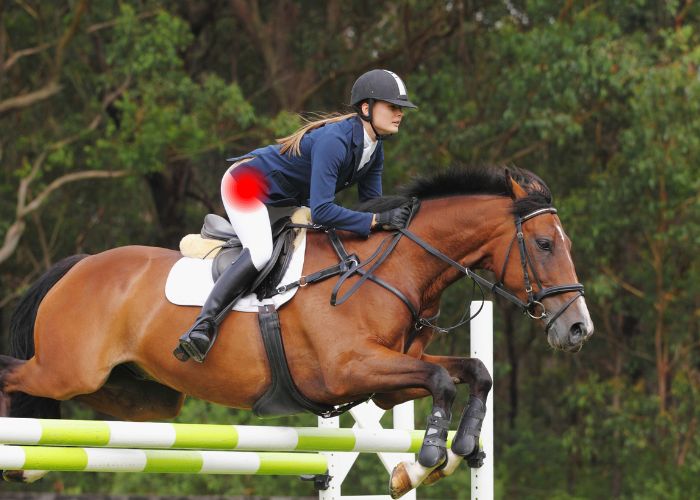What is a meniscus root tear?
There are two crescent-shaped discs of cartilage, also known as a meniscus, in each knee joint. These cartilage discs act as shock absorbers between the ends of the femur (thigh bone) and tibia (shin bone). These meniscus discs are fastened in place by two “roots” attached directly to the tibia. The meniscal roots are responsible for maintaining knee stability and function by evenly distributing weight across the tibial surface. When one or both of these meniscal roots are torn away from the bone results in a meniscus root tear. This knee condition is characterized by significant pain at the back of the knee immediately following an injury. Individuals frequently report an audible “popping” sound at the time of injury. Some other common symptoms of a meniscus root tear include difficulty bearing weight onto the affected knee and limping.

What is the treatment for a meniscus root tear?
Depending on the patient’s severity of symptoms, a meniscus root tear may initially be treated with non-operative therapies especially in cases of arthritis or chronic injury. The non-operative treatment options can include knee injections using biological material such as platelet-rich plasma or stem cells combined with a physical therapy program. However, surgical intervention may be necessary for significant meniscus root tears or when non-surgical therapy options fail to alleviate symptoms. Surgical repair can be accomplished by trimming the damaged root fragments or, preferably, suturing the root directly back down to the bone. To design an appropriate treatment plan, factors such as the patient’s age, medical history, activity level, and desired recovery goals are taken into consideration. Dr. Ronak Mukesh Patel, orthopedic knee doctor, treats patients in Sugar Land, Pearland, and the Houston, Texas area, who have experienced a meniscus root tear and are in need of surgical repair.
How is a meniscus root repair performed?
Dr. Patel begins a meniscus root repair by creating small incisions surrounding the affected knee joint. A small camera (arthroscope) is inserted through a portal to carefully examine the injury site and surrounding knee structures. Specialized surgical instruments are then introduced to clean up the injury by removing scar tissue or any unnecessary bony fragments. A bone tunnel is then drilled from the outside of the tibia into the knee joint adjacent to the native meniscus root attachment. Special surgical sutures are inserted into the meniscus root and passed through the bone tunnel in the tibia. These sutures are fastened to the bone with special surgical anchors secured within the bone. To ensure a successful repair, it is essential that the position of the meniscus root match the original “footprint” or attachment site.
What are the benefits of suturing a meniscus root tear?
Although both surgical techniques can be performed in an arthroscopic setting, trimming the damaged tissue fragments from the meniscus root may only alleviate symptoms as it does not provide a permanent solution for repairing the meniscus root tear. Dr. Patel prefers tacking the meniscal root directly to the tibia with special surgical sutures when possible. Suturing the meniscus root preserves the surrounding knee structures while preventing future arthritic damage of the knee joint. Furthermore, numerous studies have found that trimming the meniscus root tear can result in a high chance of needing a total knee replacement within 5 years of surgery. Not all orthopedic doctors are familiar with suturing the meniscus root as this specific surgical technique is much more challenging; so, it is important to consult an orthopedic doctor, like Dr. Patel, who is well-versed in performing an arthroscopic-assisted meniscus root repair correctly.
What is the recovery period like after a meniscus root repair?
Although arthroscopic surgical procedures have frequently been found to reduce a patient’s recovery time, the bones and soft-tissue structures will still take the same amount of time to heal. While most patients can expect a recovery in approximately 4-6 months. The recovery period following an arthroscopic meniscus root repair is also greatly affected by a patient’s willingness to comply with the post-operative care instructions provided by Dr. Patel. Patients in Sugar Land, Pearland, and Houston, Texas can typically anticipate the following:
- Weight-bearing is limited with the assistance of crutches and a hinged knee brace during the first 6 weeks in order to protect the surgical repair of the meniscal root.
- Range of motion exercises are introduced immediately from 0-60 degrees in weeks 0-2 and then 0-90 degrees from weeks 2-6.
- Sitting with legs crossed and deep squatting should be avoided for 3 to 4 months as this loads the meniscus root repair.
Meniscus Root Repair Surgeon

The meniscus root in the knee is essential to knee stability and function. If the root of the meniscus becomes torn, it is important to let the root heal. Sometimes the torn root needs surgical intervention to repair the tear. Meniscus root repair surgeon, Doctor Ronak Mukesh Patel, provides diagnosis as well as surgical and nonsurgical treatment options for patients in Houston, Sugar Land, and Pearland, TX who have suffered a meniscus root tear. Contact Dr. Patel’s team today!








